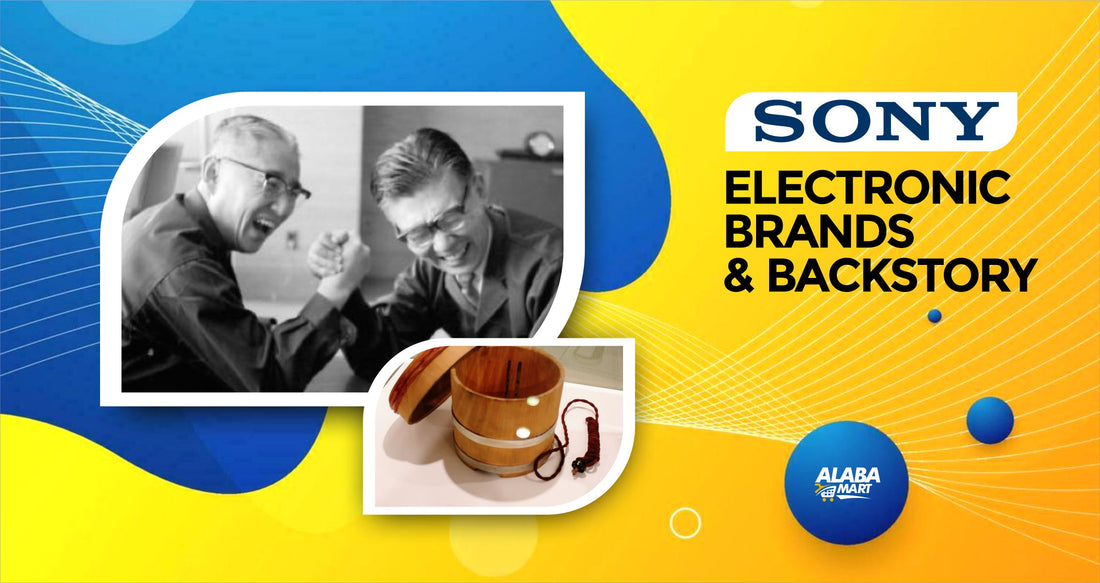
The Evolution of Sony: A Journey Through Time
Alabamart LtdThe Evolution of Sony: A Journey Through Time

Once upon a time, in the ashes of World War II, in the country of Japan, a tiny startup emerged. This was the birth of Sony Corporation, a name that would echo through seven dazzling decades, known for its boundary-pushing innovations and game-changing gadgets. Join us as we hop into our time machine and embark on an exhilarating journey through the annals of Sony's extraordinary history.
The Birth of Sony
The genesis of this extraordinary journey traces back to the year 1946 when two visionary pioneers, Masaru Ibuka and Akio Morita, co-founded Tokyo Telecommunications Engineering Corporation. Initially, their mission was to repair electronic devices, yet destiny had grander plans in store.
These two visionaries christened their brainchild with the name "Sony," a fusion of "sonus" (Latin for sound) and "sonny" (a colloquial term for a young boy). It was at this juncture that the magic truly began. Sony's inaugural technological marvel, the TR-55, marked Japan's inaugural commercially produced transistor radio—an innovation that foreshadowed a groundbreaking journey into the realm of miniaturized electronics.

In the year 1960, Akio Morita, one of the co-founders of Sony, embarked on a transformative journey by establishing Sony Corporation of America. During his time in the United States, Morita was profoundly struck by the remarkable mobility of American employees between various companies, a phenomenon quite unusual in Japan at that point in history.
Upon his return to Japan, Morita was inspired to encourage experienced and middle-aged professionals from other companies to reevaluate their career paths and consider the possibility of joining Sony. This initiative led to the filling of numerous key positions within the company and served as a catalyst for other Japanese firms to adopt similar practices. Notably, Sony played a pivotal role in Japan's emergence as a dominant exporter throughout the 1960s, 1970s, and 1980s.
Additionally, Sony's contributions extended beyond national borders. The company supplied essential components, including those used by the U.S. Military in the Vietnam War. Simultaneously, it played a significant role in enhancing the reputation of "made in Japan" products among American consumers. Sony's commitment to exceptional production quality enabled them to command premium prices for their consumer electronics, steadfastly resisting market pressures to lower prices.
Expanding Horizons
Fast forward to the swinging '60s and '70s, an era where every day was a Technicolor dream. In 1965, Sony unleashed the world's first all-transistor television, the TV8-301. Sony was now a global star in the galaxy of consumer electronics.

But wait, here's a quirky twist! In the '60s, Sony's TR-63 transistor radio, so petite it slipped into your pocket, led to a delightful rebellion. People sneaked it into movie theaters to eavesdrop on audio without paying for a ticket. This delightful caper, known as the "mini TV caper," proved that Sony's innovations sometimes got people into a bit of mischief!

But before that, Sony played an unexpected role in the Apollo 11 moon landing in 1969. The astronauts used Sony's Trinitron color TV camera to capture and transmit the first color images of Earth from space.
![]()
Then, in 1979, Sony dropped a game-changer - the Walkman. This portable cassette player waltzed into our lives, redefining how we danced to our favorite tunes. Sony's reputation for innovation soared to new heights, and it still shines today with products like
Sony XB23 EXTRA BASS™ Wireless Portable Speaker

Sony WH-1000XM4 Wireless Premium Noise Canceling Headphones

Fun Fact: One of Sony's most iconic products, the Walkman, began as a personal project of one of the company's co-founders, Masaru Ibuka. Ibuka wanted to listen to operas during long transpacific flights, but carrying a bulky tape recorder was impractical. So, he asked his engineers to create a smaller, portable version. The result was the world's first portable cassette player, which was initially known as the "Soundabout" in the United States but later became the "Walkman."
Entertainment and Technology Convergence
In the early 1980s, amid a global recession, Sony faced a challenging period as electronics sales plummeted, compelling the company to slash prices and leading to a significant drop in profits. Some analysts even went so far as to declare, "It's over for Sony," suggesting that the company's best days were in the past.
However, during this turbulent era, a visionary named Norio Ohga assumed the role of president. Ohga championed the development of the compact disc, laying the foundation for a revolutionary shift in how music was enjoyed.

The '80s had even more in store for Sony. In 1988, the company made a strategic move by acquiring CBS Records, followed by the acquisition of Columbia Pictures. These bold steps significantly expanded Sony's presence in the world of media and entertainment, giving rise to Sony Music and Sony Pictures.
During this period of transformation, Sony joined forces with Philips to co-pilot the development of the Compact Disc (CD) format, forever altering the way people listened to music. This technological advancement mirrored Sony's commitment to innovation.
In the early 1990s, a significant shift to gaming occurred in Sony's journey. It's important to note that Sony's initial foray into the world of gaming actually began as a collaboration with Nintendo. However, Sony ultimately made the momentous decision to chart its independent course, ultimately paving the way for the creation of its gaming empire.

During this pivotal period, Norio Ohga, at the helm of Sony's leadership, led the charge in developing the PlayStation gaming console. This visionary move would prove to be nothing short of seismic in the gaming universe, as PlayStation rapidly established itself as synonymous with exceptional gaming experiences.
Through this rollercoaster ride spanning the '80s and '90s, Sony not only navigated through challenging times but also transformed itself into a multimedia powerhouse, forever changing the landscape of entertainment and technology.
Under the vision of co-founder Akio Morita and his successors, the company had aggressively expanded into new businesses. Part of its motivation for doing so was the pursuit of "convergence", linking film, music and digital electronics via the Internet.This expansion proved unrewarding and unprofitable, threatening Sony's ability to charge a premium on its products as well as its brand name.
Digital Revolution and Beyond
The Sony saga continued to unfold in the early 21st century with a series of dramatic twists and transformative innovations. In the year 2000, Sony gifted the world the PlayStation 2, a record-breaking gaming console that captured the hearts of gamers worldwide. With its ability to play games online and the most extensive game library ever seen for a console, the PlayStation 2 surpassed its 64-bit rivals, the Sega Dreamcast and Nintendo GameCube, shipping a staggering 100 million units at a pace unrivaled by any of its predecessors or contemporaries.

But Sony's impact extended beyond the realm of gaming. In a historic move, Sony Pictures Entertainment released the first entirely digital film, "Final Fantasy: The Spirits Within," in 2000, setting a new standard for the film industry. Sony Pictures continued to make cinematic history with Oscar-winning films like "Crouching Tiger, Hidden Dragon" and "The Social Network.
Sony's quest for innovation persisted, leading to the creation of the renowned Bravia line of high-definition televisions. These cutting-edge displays solidified Sony's position in the world of entertainment technology and remain highly regarded to this day.

Transitioning to the realm of digital imaging technology, Sony achieved remarkable success. The introduction of the Cyber-shot line of digital cameras and the Handycam camcorders redefined how people captured and shared their precious memories. Sony's commitment to high-quality displays led to the creation of the acclaimed Sony OLED and 4K TVs, which continue to captivate audiences worldwide. here are some samples


In 2013, Sony released the PlayStation 4 (PS4), a next-generation gaming console designed to compete with the Xbox One. Critics and players alike embraced the PS4 for its outstanding graphics and seamless online multiplayer experience. It also served as a Blu-ray player and media streaming device. The ps4 had a better impact on sony’s ratings than the ps3 which came out 2007. Sony's PlayStation Now subscription service provided access to a vast library of current and legacy games.

Sony ventured into the expanding virtual reality (VR) market with the release of the PlayStation VR (PS VR) in October 2016. The PS VR system, bundled with a PS4, a VR headset, and controllers, held great promise at a price point below similar PC-based VR systems. However, unlike the ps5 that recently came out the broader VR industry faced sluggish sales, leading analysts to adjust their expectations

Conclusion: A Legacy of Innovation
Sony's journey has been filled with moments of humor and innovation, proving that even in the world of technology, laughter and creativity have their place. These anecdotes remind us that Sony's legacy is not only about groundbreaking gadgets but also the quirky and unexpected moments that make its history so fascinating. Today, Sony continues to innovate across multiple sectors, including electronics, gaming, entertainment, and more, with the PlayStation 5 taking gaming to new heights and the company remaining at the forefront of 4K and 8K display technology. Sony's journey through time is a testament to its unwavering commitment to innovation and excellence. From its humble beginnings as a small repair shop to its current status as a global tech powerhouse, Sony has consistently pushed the boundaries of what is possible in the world of electronics and entertainment. With a legacy of groundbreaking products and a spirit of continuous innovation, Sony is poised to shape the future of technology for generations to come. If you’re interested in top shelf quality, Sony is the way to go, and to avoid buying damaged or fake products, Alabamart is the shop to visit. The product of your choice will be delivered in the fastest possible time, and installation services are also available

